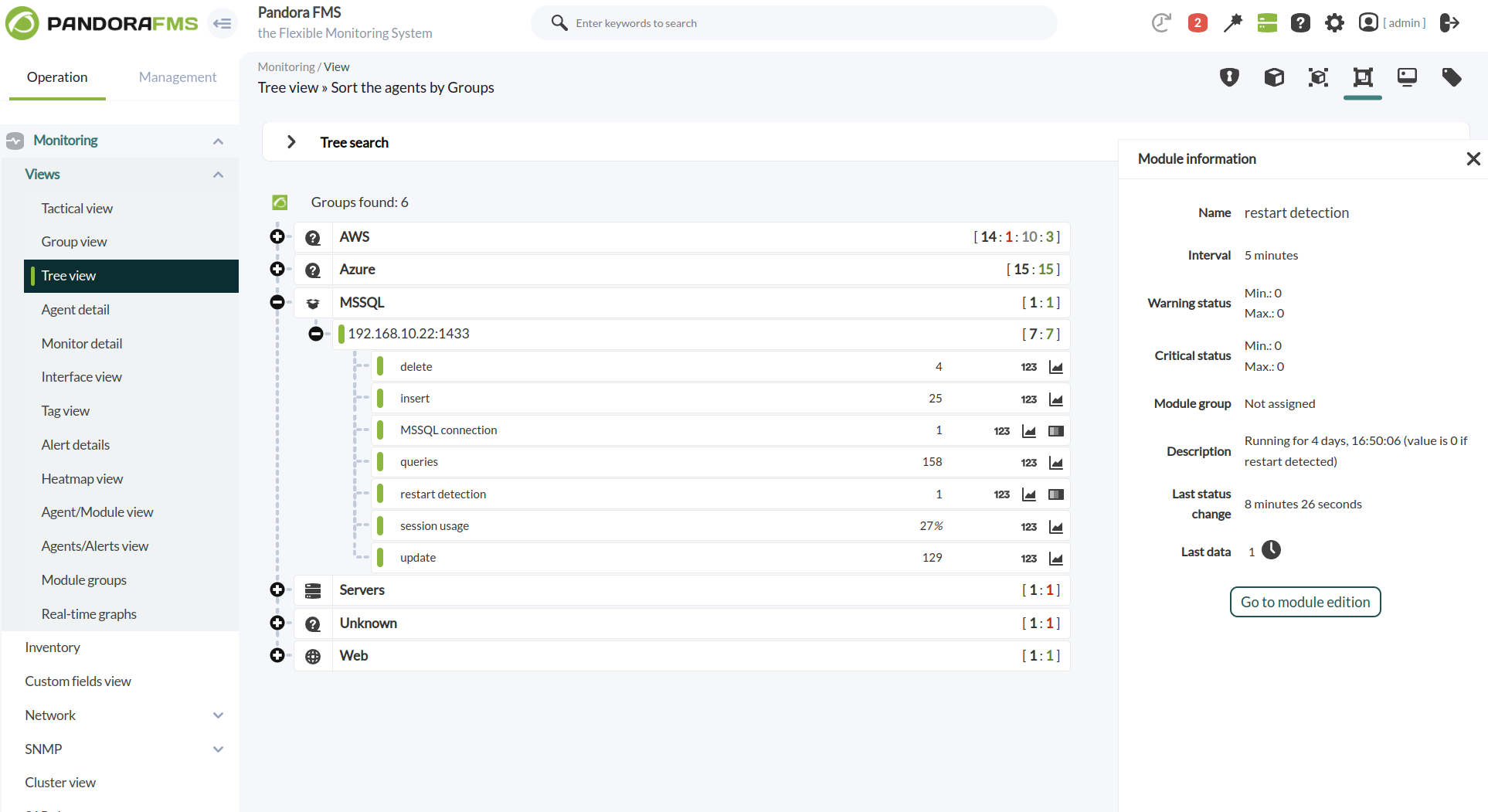Microsoft SQL Server Advanced Monitoring with Pandora FMS
Simplify the management of your Microsoft SQL Server databases with Pandora FMS
Get detailed metrics, customize queries, and optimize your infrastructure performance from a single interface.
Why monitor Microsoft SQL Server?
Microsoft SQL Server is critical to the technology infrastructure of many companies. Efficient monitoring enables:

Early Problem Detection
Identify unexpected restarts and anomalies before they affect your operations.

Proactive scalability planning
Anticipate the future needs of your infrastructure, ensuring sustainable growth.

Real-time analysis
Collect key metrics to understand how your database is performing under different loads.

Efficient resource management
Analyze the use of active sessions against the total available to prevent failures and optimize capacity.

Performance optimization
Evaluate the efficiency of SELECT, INSERT, UPDATE, and DELETE queries to identify bottlenecks and improve user experience.
Proper monitoring is key to ensure the continuity and performance of your SQL Server infrastructure.
Why monitor Microsoft SQL Server with Pandora FMS?
Pandora FMS simplifies SQL Server monitoring with advanced tools that enable:

Visibility segmentation
Custom dashboards and reports for specific teams or customers.

Selecting predefined metrics
Access key data such as uptime, connection usage, or query statistics.

Custom queries as metrics
Set up specific monitoring based on your infrastructure needs.

Remote connection without local installation
Monitor multiple databases from a single central point.

Efficient multi-instance management
Adjust metrics and intervals according to the severity of each database.

Configurable and immediate alerts
Real-time notifications by email, SMS or tools such as Telegram.
all-in-one software
Get complete control over the performance and stability of your SQL Server environment
Ensure that all your services are monitored efficiently and in real time.
Request a Demo →

Key Pandora FMS features for SQL Server
Real-time analysis and alerts
Monitor the performance of your SQL Server databases with detailed reports and graphs that combine key metrics. Receive immediate and configurable alerts through email, SMS, Telegram or chat tools, ensuring you react to any critical changes in your environment.
Adapting to hybrid environments
Pandora FMS is not limited to SQL Server. Extend monitoring to other hybrid environments, including on-premise databases, cloud services, and third-party virtual machines. Manage all your needs from a single centralized platform.
Efficient management of multiple instances
Pandora FMS allows you to manage multiple SQL Server servers simultaneously. The platform also gives you segmented visibility, assigning different access levels to groups or customers, for more flexible and efficient management.
Predefined and custom metrics
Access a wide range of predefined metrics specific to SQL Server, such as CPU usage, memory, active connections, and query performance. In addition, customize queries to monitor unique aspects of your infrastructure, ensuring complete visibility of your systems.
Total control from a single platform
Centralize monitoring of all your SQL Server databases in one intuitive interface. With support for hybrid and multi-instance environments, Pandora FMS ensures unified monitoring that adapts to any business scenario.

Easy and efficient setup
Setting up SQL Server monitoring with Pandora FMS is quick and easy. Follow these steps from the Discovery Server:
1. Select SQL Server on Discovery Server
From the Discovery menu, select the “Applications” option and click “Microsoft SQL Server”.
2. Define the basic parameters
Enter a descriptive name, description, agent group, and monitoring interval.
3. Enter credentials and define servers
Adds the user credentials needed to connect to the databases.
Set up a list of servers to connect to and run monitoring. This will allow you to manage multiple instances of SQL Server from a single task.
4. Customize metrics
Define the number of threads that the task will use, adjusting them according to the number of configured custom instances and queries. Configure an agent name to store the monitoring information. Assign a prefix for the modules generated by the task. Select the metrics you wish to include in the default monitoring and add custom queries based on the specific needs of your infrastructure.
5. Review and monitor
View the status of Discovery tasks and get a detailed summary of their execution.
In addition, you will be able to see in detail the summary of the execution in a simple way.
Results
Running this task will return different results depending on the metrics enabled in the monitoring section or if custom queries were defined. Pandora FMS offers a full range of predefined metrics, plus the ability to add custom queries:
Null
If engine_uptime is enabled:
restart_detection
It will be 0 if an unexpected restart was detected, and 1 if this is not the case. When a server restarts unexpectedly, there can be an interruption in access to the database and transactions or data that are not properly saved may be potentially lost.
If query_stats is enabled
queries
Total number of queries. Monitoring queries is essential to understand the workload that is running on the server and assess the overall system performance. By monitoring the total number of queries, you may identify peaks in activity, optimize performance, and spot potential issues, such as inefficient or excessive queries.
update
Number of UPDATE queries. UPDATE queries are used to modify existing data in the database. Monitoring UPDATE queries is important to assess the frequency and efficiency of data updates. You may identify UPDATE queries that affect a large number of rows or have a significant impact on server performance. This allows you to optimize queries, double check table structure or take steps to reduce the load generated by updates.
delete
Number of DELETE queries. DELETE queries are used to retrieve data from the database. Monitoring DELETE queries is useful for assessing the frequency and efficiency of data deletions. You may identify DELETE queries that affect a large number of rows or have a significant impact on server performance. This allows you to optimize queries, double check table structure or take steps to reduce the load generated by deletions.
insert
Number of INSERT queries. INSERT queries are used to enter new data into the database. Monitoring INSERT queries allows you to assess the frequency and efficiency of data insertions. You may identify INSERT queries that generate a high load on the server or that could be causing performance issues. This allows you to optimize queries, double check table structure, or consider delayed insertion strategies to improve performance in high-concurrency environments.
If analyze_connections is enabled
session usage
Number of current connections regarding the total maximum connections. Monitoring session usage in SQL Server is important for optimizing performance, identifying blocking issues, improving security and auditing, and efficiently planning server resources.
* The task will also create a module for each custom query defined in the configuration file.
pandora fms resources
Want to learn more? Explore more resources
Take your monitoring to the next level with Pandora FMS
Microsoft SQL Server is a linchpin in many organizations, and Pandora FMS offers the advanced monitoring you need to ensure its stability and performance. From early problem detection to scalability planning, Pandora FMS provides you with all the tools to maximize the operation of your SQL Server infrastructure.















